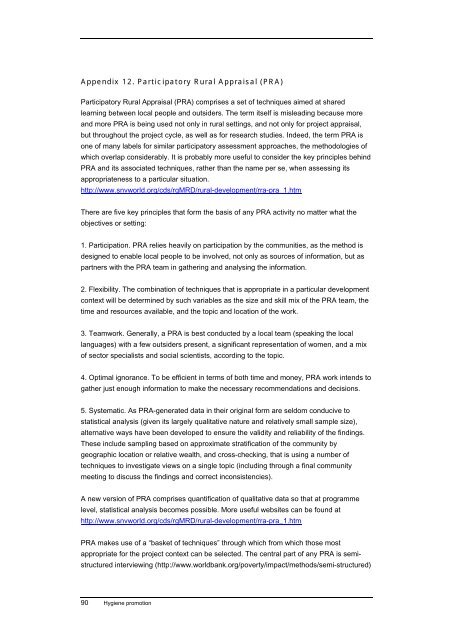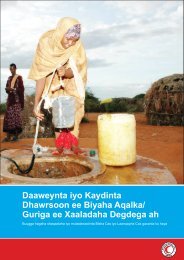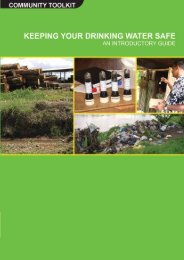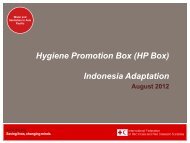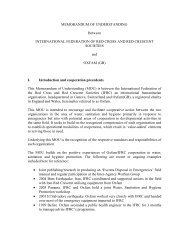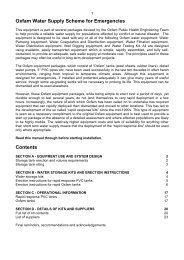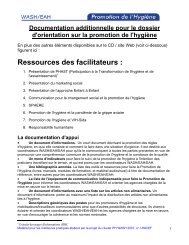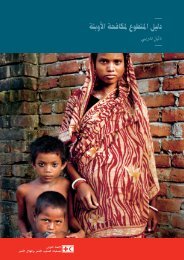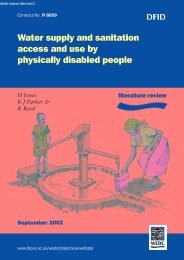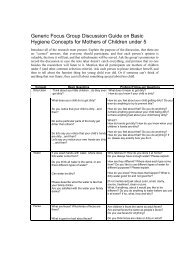Appendix 12. Participatory Rural Appraisal (PRA)Participatory Rural Appraisal (PRA) comprises a set of techniques aimed at sharedlearning between local people <strong>and</strong> outsiders. The term itself is misleading because more<strong>and</strong> more PRA is being used not only in rural settings, <strong>and</strong> not only for project appraisal,but throughout the project cycle, as well as for research studies. Indeed, the term PRA isone of many labels for similar participatory assessment approaches, the methodologies ofwhich overlap considerably. It is probably more useful to consider the key principles behindPRA <strong>and</strong> its associated techniques, rather than the name per se, when assessing itsappropriateness to a particular situation.http://www.snvworld.org/cds/rgMRD/rural-development/rra-pra_1.htmThere are five key principles that form the basis of any PRA activity no matter what theobjectives or setting:1. Participation. PRA relies heavily on participation by the communities, as the method isdesigned to enable local people to be involved, not only as sources of information, but aspartners with the PRA team in gathering <strong>and</strong> analysing the information.2. Flexibility. The combination of techniques that is appropriate in a particular developmentcontext will be determined by such variables as the size <strong>and</strong> skill mix of the PRA team, thetime <strong>and</strong> resources available, <strong>and</strong> the topic <strong>and</strong> location of the work.3. Teamwork. Generally, a PRA is best conducted by a local team (speaking the locallanguages) with a few outsiders present, a significant representation of women, <strong>and</strong> a mixof sector specialists <strong>and</strong> social scientists, according to the topic.4. Optimal ignorance. To be efficient in terms of both time <strong>and</strong> money, PRA work intends togather just enough information to make the necessary recommendations <strong>and</strong> decisions.5. Systematic. As PRA-generated data in their original form are seldom conducive tostatistical analysis (given its largely qualitative nature <strong>and</strong> relatively small sample size),alternative ways have been developed to ensure the validity <strong>and</strong> reliability of the findings.These include sampling based on approximate stratification of the community bygeographic location or relative wealth, <strong>and</strong> cross-checking, that is using a number oftechniques to investigate views on a single topic (including through a final communitymeeting to discuss the findings <strong>and</strong> correct inconsistencies).A new version of PRA comprises quantification of qualitative data so that at programmelevel, statistical analysis becomes possible. More useful websites can be found athttp://www.snvworld.org/cds/rgMRD/rural-development/rra-pra_1.htmPRA makes use of a “basket of techniques” through which from which those mostappropriate for the project context can be selected. The central part of any PRA is semistructuredinterviewing (http://www.worldbank.org/poverty/impact/methods/semi-structured)90 <strong>Hygiene</strong> promotion
While sensitive topics are often better addressed in interviews with individuals, other topicsof more general concern are amenable to focus group discussions <strong>and</strong> communitymeetings (http://www.worldbank.org/poverty/impact/methods/indgroup.htm#focusgroup).During these interviews <strong>and</strong> discussions, several diagrammatic techniques are frequentlyused to stimulate debate <strong>and</strong> record the results. Many of these visuals are not drawn onpaper but on the ground with sticks, stones, seeds, <strong>and</strong> other local materials, <strong>and</strong> thentransferred to paper for a permanent record.Some of the key PRA diagrammatictechniques are:• Mapping techniques (http://www.worldbank.org/poverty/impact/methods/mapping.htm)• Ranking exercises (http://www.worldbank.org/poverty/impact/methods/ranking.htm)• Trend analysis (http://www.worldbank.org/poverty/impact/methods/trend.htm)Visual-based techniques are important tools for enhancing a shared underst<strong>and</strong>ingbetween outsiders <strong>and</strong> insiders, but may hide important differences of opinion <strong>and</strong>perspective when drawn in group settings, <strong>and</strong> may not reveal cultural-based information<strong>and</strong> beliefs adequately. They therefore need to be complemented by other techniques,such as careful interviewing <strong>and</strong> observation, to crosscheck <strong>and</strong> supplement the results ofdiagramming.PRA involve some risks <strong>and</strong> limitations. Many of them are not unique to this method butare inherent in any research method that aims to investigate local conditions. One of themain problems is the risk of raising expectations. This may be impossible to avoid, but canbe minimized with careful <strong>and</strong> repeated clarification of the purpose of the PRA <strong>and</strong> the roleof the team in relation to the project, or government, at the start of every interview <strong>and</strong>meeting. Trying to use PRA as a st<strong>and</strong>ard survey to gather primarily quantitative data,using large sample sizes, <strong>and</strong> a questionnaire approach could greatly compromise thequality of the work <strong>and</strong> the insights produced. And, if the PRA team is not adequatelytrained in the methodology before the work begins, there is often a tendency to use toomany different techniques, some of which are not relevant to the topic at h<strong>and</strong>. In general,when a training element is involved, there will be a trade-off between the long-termobjective of building the capacity of the PRA team <strong>and</strong> getting good quality results in theirfirst experience of using the methodology.Furthermore, one common problem is that insufficient time is allowed for the team to relaxwith the local people, to listen to them, <strong>and</strong> to learn about the more sensitive issues underconsideration. Rushing will also often mean missing the views of the poorest <strong>and</strong> leastarticulate members of the communities visited. The translation of PRA results into ast<strong>and</strong>ard evaluation report poses considerable challenges, <strong>and</strong> individuals unfamiliar withparticipatory research methods may raise questions about the credibility of the PRAfindings.A paper on common flaws in practicing PRA is online available athttp://www.snvworld.org/cds/rgMRD/rural-development/rra-pra_1.htm<strong>IRC</strong> <strong>International</strong> <strong>Water</strong> <strong>and</strong> <strong>Sanitation</strong> <strong>Centre</strong> 91
- Page 2:
Please note that the TOPs are a web
- Page 7 and 8:
1. Hygiene PromotionWhat do you kno
- Page 9 and 10:
2. Why hygiene promotion matters2.1
- Page 11 and 12:
• The costs of inaction can be hi
- Page 13 and 14:
3. Learning from experiences and re
- Page 15 and 16:
• Hygiene Improvement Framework (
- Page 17 and 18:
groups, and facilitators of partici
- Page 19 and 20:
The diagrams are taken from McKee
- Page 21 and 22:
• Food, utensils and food prepara
- Page 23 and 24:
Guides for developing hygiene promo
- Page 25 and 26:
• What may prevent this change in
- Page 27 and 28:
areas, slabs and sanplats for latri
- Page 29 and 30:
often not taken seriously and their
- Page 31 and 32:
IIIIIIIVVInputsProcOutpEffectiImpae
- Page 33 and 34:
over for reasons of hierarchy, e.g.
- Page 35 and 36:
5. Case studiesOn the following pag
- Page 37 and 38:
The Project recognises the importan
- Page 39 and 40:
almost all cases been exceeded, as
- Page 41 and 42: skin diseases, HIV/AIDS and tubercu
- Page 43 and 44: understanding of the importance of
- Page 45 and 46: councils (JSCs) are associations of
- Page 47 and 48: o through a schools programme, with
- Page 49 and 50: outputs and outcomes are focused mo
- Page 51 and 52: Harvey, Eric, Shadrack Dau, Alana P
- Page 53 and 54: programmes more effective. The obje
- Page 55 and 56: scale. Comparison is on approach, l
- Page 57 and 58: Hygiene Behaviour Network, in Globa
- Page 59 and 60: WHO - World Health Organizationhttp
- Page 61 and 62: Tel: (703) 247-8730Fax: (703) 243-9
- Page 63 and 64: Manila, PhilippinesTel: +632 911-57
- Page 65 and 66: TOP Courses and conferencesCREPA, B
- Page 67 and 68: TOP ReferencesBoot, Marieke T. and
- Page 69 and 70: TOP Quiz on Hygiene PromotionTry it
- Page 71 and 72: Question 4All the interventions wil
- Page 73 and 74: Then you may decide that this paper
- Page 75 and 76: Appendix 1. Hygiene promotion manua
- Page 77 and 78: 2. Target specific audiences.These
- Page 79 and 80: Appendix 4. WASH facts and figures1
- Page 81 and 82: Research)18: (IHE Newsletter, Janua
- Page 83 and 84: Appendix 6. Preventive measuresMeas
- Page 85 and 86: Appendix 8. Some key objectives for
- Page 87 and 88: Appendix 9. Participatory tools and
- Page 89 and 90: Appendix 10. The PHAST approachFor
- Page 91: Planning techniques are used to sim
- Page 95: About IRCIRC facilitates the sharin


